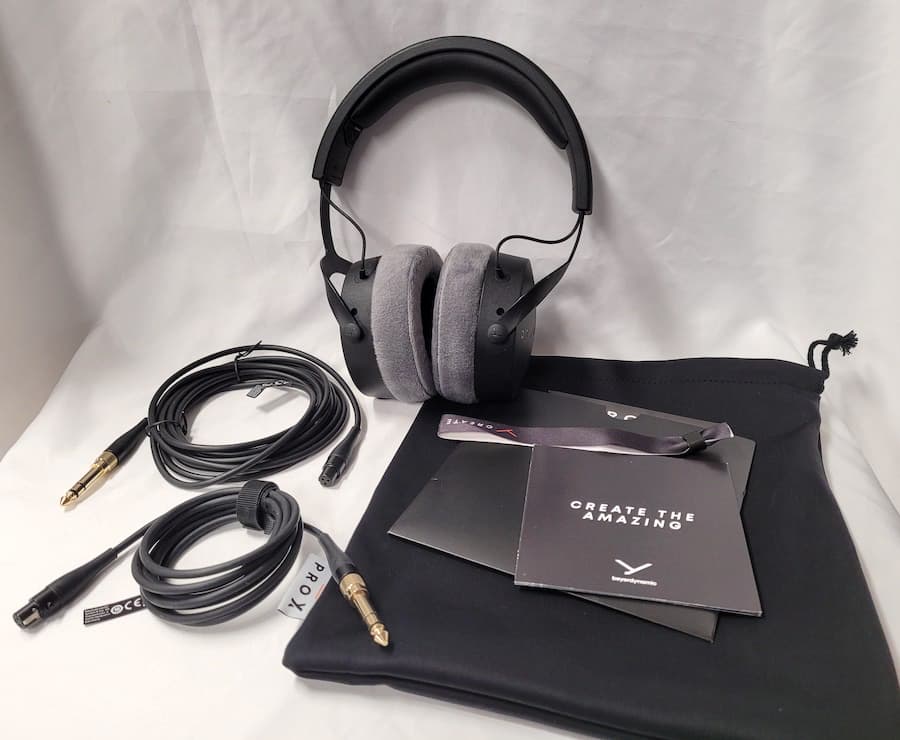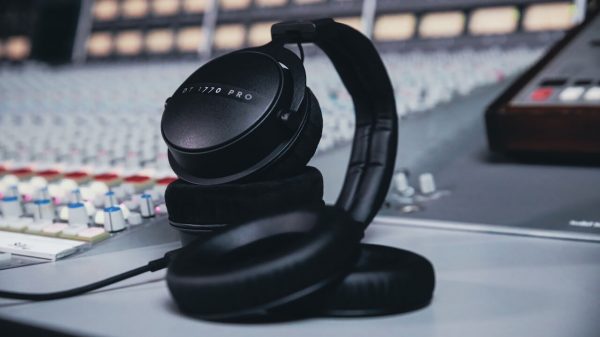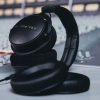In my January review of the Beyerdynamic DT 900 Pro X open-back Headphones, I was quite surprised by how much performance the company was able to squeeze out of such an affordable pair of headphones; they are one of the best I’ve heard around $300 USD.
I’m a long-term Beyerdynamic customer with some of their more expensive flagship models in my collection and I was nervous that they couldn’t replicate the magic at that super competitive price point. I could not have been more wrong. Does lightning strike twice with the Beyerdynamic DT 700 Pro X closed-back model?
Beyerdynamic was founded by Eugen Beyer in 1924 and made its mark with its first series of cinema loudspeakers. Beyer was born in St. Petersburg but the family found itself stranded in Berlin at the start of World War I and after a short period in Sweden, Beyer enrolled at the Technische Universität Berlin.

After nearly a century of groundbreaking technological innovation, Beyerdynamic is pushing hard into the gaming space with the $299 Beyerdynamic DT 700 Pro X Headphones.
The German/Austrian market is very proud of its 3 heritage brands and for very good reason.
Beyerdynamic, Sennheiser, and AKG are also 3 companies in transition. AKG is now owned by Samsung which purchased Harman, Sennheiser has new ownership which has created a degree of flux, and Beyerdynamic is still owned by the Beyer family.
After almost a century, Beyerdynamic has a legion of fans but it’s definitely not as well known from a mainstream perspective.

Was ist Neu?
The Beyerdynamic DT 700 Pro X are the successor to the DT 770 Pro model, and this closed-back design has a number of new design features that gives it a larger sounding soundstage and the obvious benefit of very little leakage to annoy your family and co-workers.
The DT 900 Pro X are an open-back design and sound more spacious but the leakage is a major issue if listening on the train or at your desk.
Both headphones have huge shoes to fill because the DT models have been used around the globe in studios for almost 30 years and most headphone enthusiasts have owned or tried a pair in their lifetime.

From a design perspective, the DT 700 Pro X looks very much like its predecessor with round ear cups, stamped gimbals, velour earpads, and a padded headband with metal inserts to increase strength.
If something isn’t broken when it comes to durability, it’s often a mistake to cut corners or try to become too chic with the industrial design. Beyerdynamic understand their customers and that didn’t happen here.
The new models both sport a matte black finish with grey velour pads rather than the brushed metal louvered look of the DT990 Pro. Also new, is the removable cable featuring a mini-XLR connector on the left cup.

I do wish they had used a 4-pin connector so balanced cables could be used out of the box, but the addition of a removable cable is a big step in the right direction; it clearly shows that Beyerdynamic is listening to users in the Head-Fi and gaming community.
Another big step forward is the method of pad attachment which is now a clip-on system with an indexing key on the pad that aligns to a slot in the cup to assure correct alignment. The new pads snap on/off more easily and you can feel that the connection is more secure.
The Kishkas
EIC Ian White loves to throw Yiddish expressions into my reviews; especially when it comes to German and Austrian products and I’ve promised to go for some “kishka” and deli with him in NYC when I finally make it up there.
The “guts” of any headphone are incredibly important and it’s very clear that the engineers at Beyerdynamic really thought these products through.
Internally, the drivers retain the 45 mm size of the previous models, but are a completely new design that Beyerdynamic calls the Stellar45. This new driver sports a good bit of trickle down technology from the higher end models with improved frequency response on both ends of the spectrum and a higher sensitivity rating.
At 48 ohms, the impedance is on the high side for use with a lot of entry-level DAPs and some Dongle DACs — but the 98.2dB/mW sensitivity rating makes the Beyerdynamic DT 700 Pro X usable with most sources.
The distortion levels are also really impressive for a headphone at this price point; 0.04% at 1kHz and only 0.4% at 100Hz. These measurements would have qualified only a few years ago as rather solid and something one would expect on much more expensive headphones.
On paper, the Stellar45 driver technology looks very promising.
One interesting design feature that you don’t see on a lot of headphones is that the drivers can be changed on the DT Pro X models without special tools or the need for soldering.
I’ll be waiting all day for a list of current headphones where one can remove and replace the drivers with ease.

Between the new materials, removable cable, and toolless replacement of drivers, the new Pro X models offer the end user a sustainable product that few other models can compete with.
This should help the popularity of the Pro X models in schools, studios, and other environments where treatment of headphones borders on abuse.
So yes — the kishkas on the DT 900 Pro X are in great shape. Just no gravy.
Sound
The DT 700 Pro X is going to be used in a lot of studios and I expected the new model to be quite linear sounding with excellent detail retrieval. I also hoped that Beyerdynamic tuned them to respond well to EQ so the mix changes are accurately reproduced. Based on the measurements and frequency response, I had high hopes for these.
The DT 700 Pro X has good bass impact and delivers solid extension when called upon with roll-off being well into the lower 20Hz range before becoming evident. The mid-bass has good slam when called upon again without stealing the show when it shouldn’t.
Those who own the older DT 770 model will notice that the DT 700 Pro X deliver deeper bass with more extension and texture; I also felt that the transient response was improved as well.

The lower midrange does exhibit some thickness and warmth but that becomes less of an issue as we crossover into the rest of the midrange and lower treble.
Overall, the midrange is not perfectly neutral which is typical of Beyerdynamic designs; the degree of coloration does not take away from the fact that these are very clean sounding headphones and transients are much faster which helps reveal more detail.
Male vocals cut through the mix well but don’t jump out in front while female voices do seem to be a bit further forward in the mix. Strings have good energy but are just slightly lean sounding.
The lower treble does have a mild boost but less so than the earlier DT 770, and the result is that the DT 700 Pro X sounds less strident than the 770.
There is still an emphasis here but not nearly as pronounced as it was on the older model. Cymbals have a lot of energy without the metallic edge present on the DT 770 and snare rattle is a bit more realistic with crisp edges and good rasp.
The emphasis in the lower treble drops back as we move above 7kHz and the 11kHz spike of the earlier DT 770 is gone; the top end here is more polite and less fragile sounding.
The DT 700 Pro X is still slightly bright sounding due to the early treble emphasis but the new tuning is much easier to accept at higher listening levels and during extended listening sessions.
The soundstage takes a genuine step forward with the new DT 700 Pro X model; something that was a serious shortcoming of the DT 770. Closed-back headphones don’t sound as spacious as open-back models but the DT 700 Pro X delivers a bit more width than depth, and there is more than enough height to give everything enough space to create proper stereo separation and above average imaging.
The DT 900 Pro X is more accomplished in that regard but it trades some performance in the low end to achieve this; I think most people will find the soundstage quite sufficient for a closed-back headphone.

Conclusion
Did I like the Beyerdynamic DT 700 Pro X enough to warrant a strong buying recommendation?
Beyerdynamic has dominated the studio market for many years with the DT 770 ($159 at Amazon), DT 880 ($199 at Amazon) and DT 990 models ($159 at Amazon), and it’s fair to say that they rarely introduce a clunker.
If you’re looking for a closed-back monitoring headphone that will last and delivers in most areas — the DT 700 Pro X is a strong option for a few reasons.
The soundstage performance has been improved significantly, and I really liked the changes in the low end, and the lack of hardness in the treble. The headphone is receptive to EQ which makes it a good option for the studio and it’s manufactured by a company that cares about durability, and providing value for your money.
I suspect Beyerdynamic will find real success with both the DT 700 Pro X and DT 900 Pro X models which are available for a very reasonable amount of money.
Where to buy: $299 at Amazon | Audio46 | beyerdynamic.com
Related reading: Beyerdynamic DT 900 Pro X Headphones Review (open-back)





































